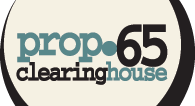
25249.5. Prohibition On Contaminating Drinking Water With Chemicals Known to Cause Cancer or Reproductive Toxicity.
No person in the course of doing business shall knowingly discharge or release a chemical known to the state to cause cancer or
reproductive toxicity into water or onto or into land where such chemical passes or probably will pass into any source of drinking water,
notwithstanding any other provision or authorization of law except as provided in Section 25249.9. 25249.6. Required Warning Before
Exposure To Chemicals Known to Cause Cancer Or Reproductive Toxicity.No person in the course of doing business shall knowingly and
intentionally expose any individual to a chemical known to the state to cause cancer or reproductive toxicity without first giving clear
and reasonable warning to such individual, except as provided in Section 25249.10 Prohibition On Contaminating Drinking Water With Chemicals Known to Cause Cancer or Reproductive Toxicity.
No person in the course of doing business shall knowingly discharge or release a chemical known to the state to cause cancer or
reproductive toxicity into water or onto or into land where such chemical passes or probably will pass into any source of drinking water,
notwithstanding any other provision or authorization of law except as provided in Section 25249.9. 25249.6. Required Warning Before
Exposure To Chemicals Known to Cause Cancer Or Reproductive Toxicity.No person in the course of doing business shall knowingly and
intentionally expose any individual to a chemical known to the state to cause cancer or reproductive toxicity without first giving clear
and reasonable warning to such individual, except as provided in Section 25249.10.